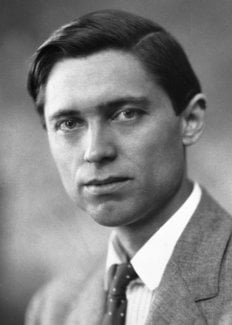The Svedberg
Biographical
 Theodor (The) Svedberg was born at Fleräng, Valbo, in the county of Gävleborg, Sweden on August 30, 1884, as the son of Elias Svedberg, a works manager, and his wife, Augusta, née Alstermark. He attended the Köping School, the Örebro High School and Gothenburg Modern School, where he passed his student examination in December 1903, before matriculating and beginning his lifelong association with Uppsala University in January 1904. He gained his Bachelor of Arts degree in 1905, his Master’s degree in 1907 and his Doctor of Philosophy in 1908.
Theodor (The) Svedberg was born at Fleräng, Valbo, in the county of Gävleborg, Sweden on August 30, 1884, as the son of Elias Svedberg, a works manager, and his wife, Augusta, née Alstermark. He attended the Köping School, the Örebro High School and Gothenburg Modern School, where he passed his student examination in December 1903, before matriculating and beginning his lifelong association with Uppsala University in January 1904. He gained his Bachelor of Arts degree in 1905, his Master’s degree in 1907 and his Doctor of Philosophy in 1908.
Svedberg accepted a post as assistant in the Chemical Institute at Uppsala in 1905 and in 1907 he was given the additional position of lecturer in chemistry in the university. He obtained a special appointment in 1909 as lecturer and demonstrator of physical chemistry and in 1912 he was elected Professor of Physical Chemistry, University of Uppsala. He was made emeritus in 1949, since when he has been Director of the Gustaf Werner Institute for Nuclear Chemistry in the University.
Svedberg’s work has mainly been concerned with colloids and macromolecular compounds. In his doctor’s thesis Studien zur Lehre von den kolloiden Lösungen (1908), now considered as a classic, he described a new method of producing colloid particles and gave convincing evidence of the validity of the theory founded by Einstein and von Smoluchowski on the Brownian movements, thereby providing definite proof of the existence of molecules. With numerous collaborators he has studied the physical properties of colloids, such as their diffusion, light absorption, and sedimentation, from which could be concluded that the gas laws could be applied to disperse systems. For the study of sedimentation he constructed his well-known ultracentrifuge, where large molecules in solution, such as proteins, carbohydrates, and high polymers have been investigated. In the ultracentrifuge the large molecules are put under the influence of centrifugal forces up to about 106 gravity. The findings were related to molecular size and shape. He showed that the molecules of certain pure proteins are all of one size and demonstrated the use of the ultracentrifuge to show the presence of contaminants. Later, he turned his attention to the problems of nuclear chemistry and radiation biology. He has also studied photographic processing, and assisted in photographing the famous Codex argenteus in colour, which made this source of the Gothic language available for research. During the Second World War he worked out a method for making synthetic rubber.
Svedberg has contributed a large number of scientific papers to Swedish and foreign journals on colloid and high-molecular solutions, nuclear chemistry and radiation biology.
Among his publications the following books should be mentioned: Die Methoden zur Herstellung kolloider Lösungen anorganischer Stoffe (1909), Die Existenz der Moleküle (1912), Colloid Chemistry (1914; sec. enl. ed. with A. Tiselius 1928 ), The Ultracentrifuge (with K.O. Pedersen 1940; also in German). He has written several excellent popular books in Swedish, namely Materien (1912; sec. ed. 1919; also German ed. 1914), Arbetets dekadens (1915, 1920; German ed. 1923) and Forskning och Industri (1918).
He has been awarded the John Ericsson Medal (1942), the Berzelius Medal (1944), and the Medal of the Franklin Institute (1949). For his work on the disperse systems he received the Nobel Prize in 1926.
To extend his knowledge Svedberg has visited numerous laboratories in foreign countries and cities: Germany (1908), Holland and France (1912), Berlin (1913), Vienna (1916), London and Paris (1920), England and Denmark (1922), the United States and Canada (1922-1923).
He has been awarded honorary doctor’s degrees in science and medicine, and, amongst many other academies and learned societies, he is a member of the Swedish Academy of Sciences, the Halle Academy, The Chemical Society (London), the Indian Academy of Science, the American Philosophical Society (Philadelphia), the New York Academy of Sciences, the Royal Society (London) and the National Academy of Science (Washington).
Svedberg has married four times: in 1909, Andrea Andreen, a medical graduate; in 1916, Jane Frodi; Ingrid Blomquist in 1938; and in 1948, Margit Hallén, M.A. He has twelve children, six sons and six daughters.
His hobbies are painting and botany.
This autobiography/biography was written at the time of the award and first published in the book series Les Prix Nobel. It was later edited and republished in Nobel Lectures. To cite this document, always state the source as shown above.
The Svedberg died on February 25, 1971.
Nobel Prizes and laureates
Six prizes were awarded for achievements that have conferred the greatest benefit to humankind. The 14 laureates' work and discoveries range from quantum tunnelling to promoting democratic rights.
See them all presented here.
